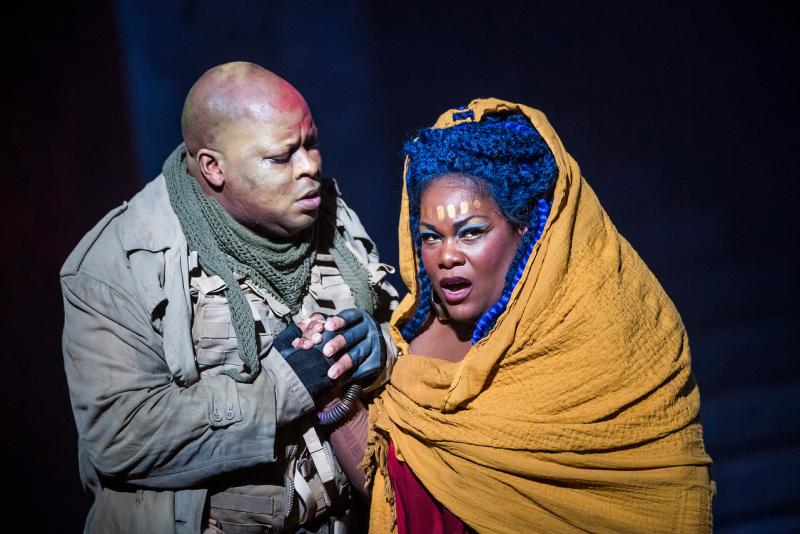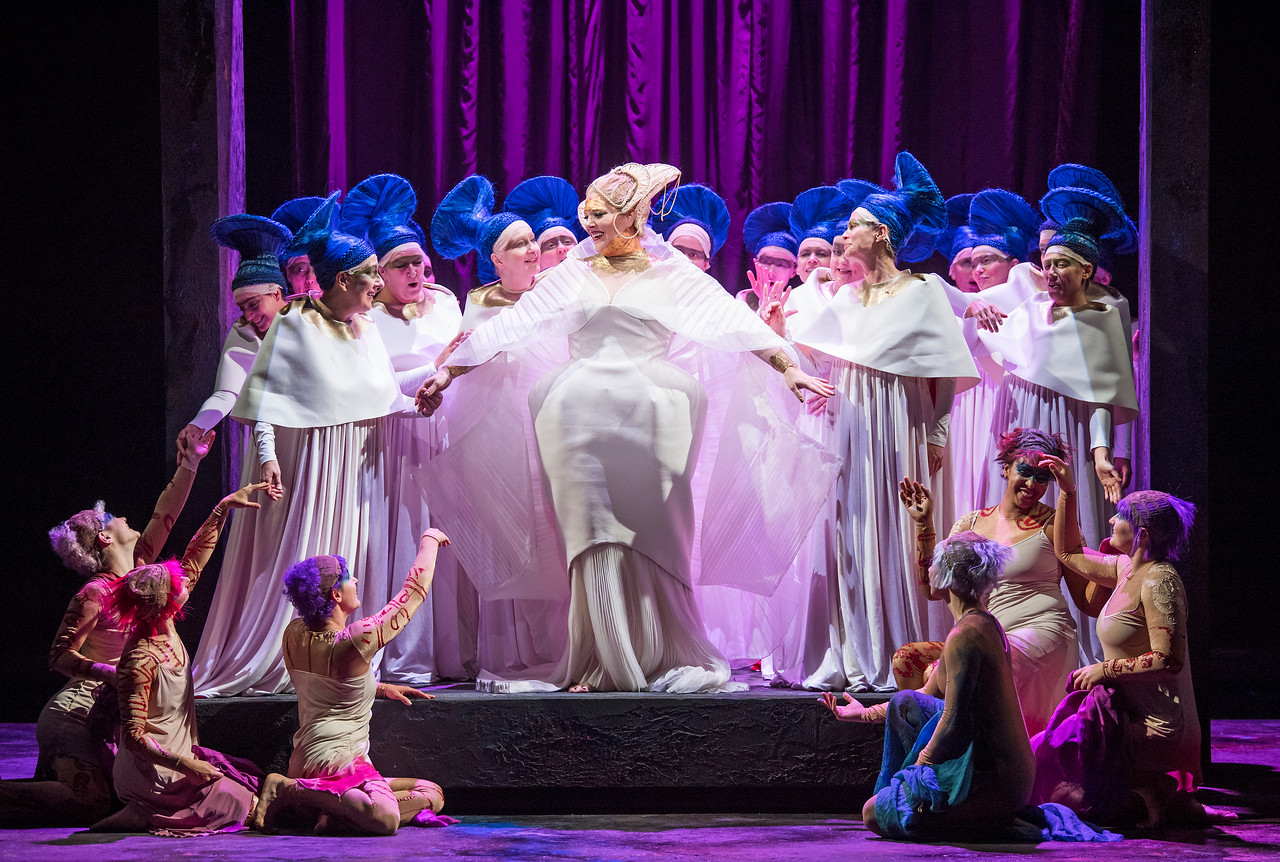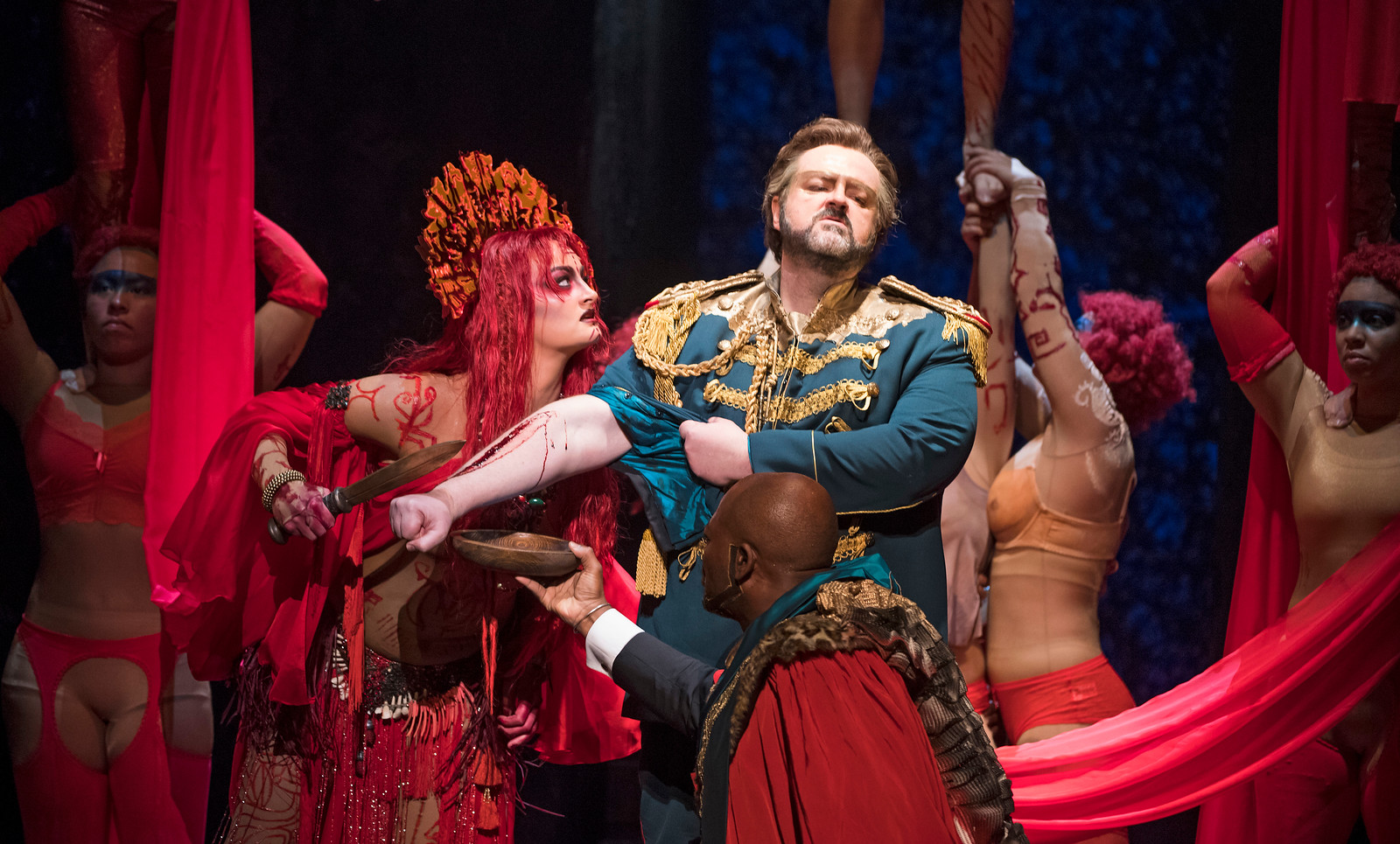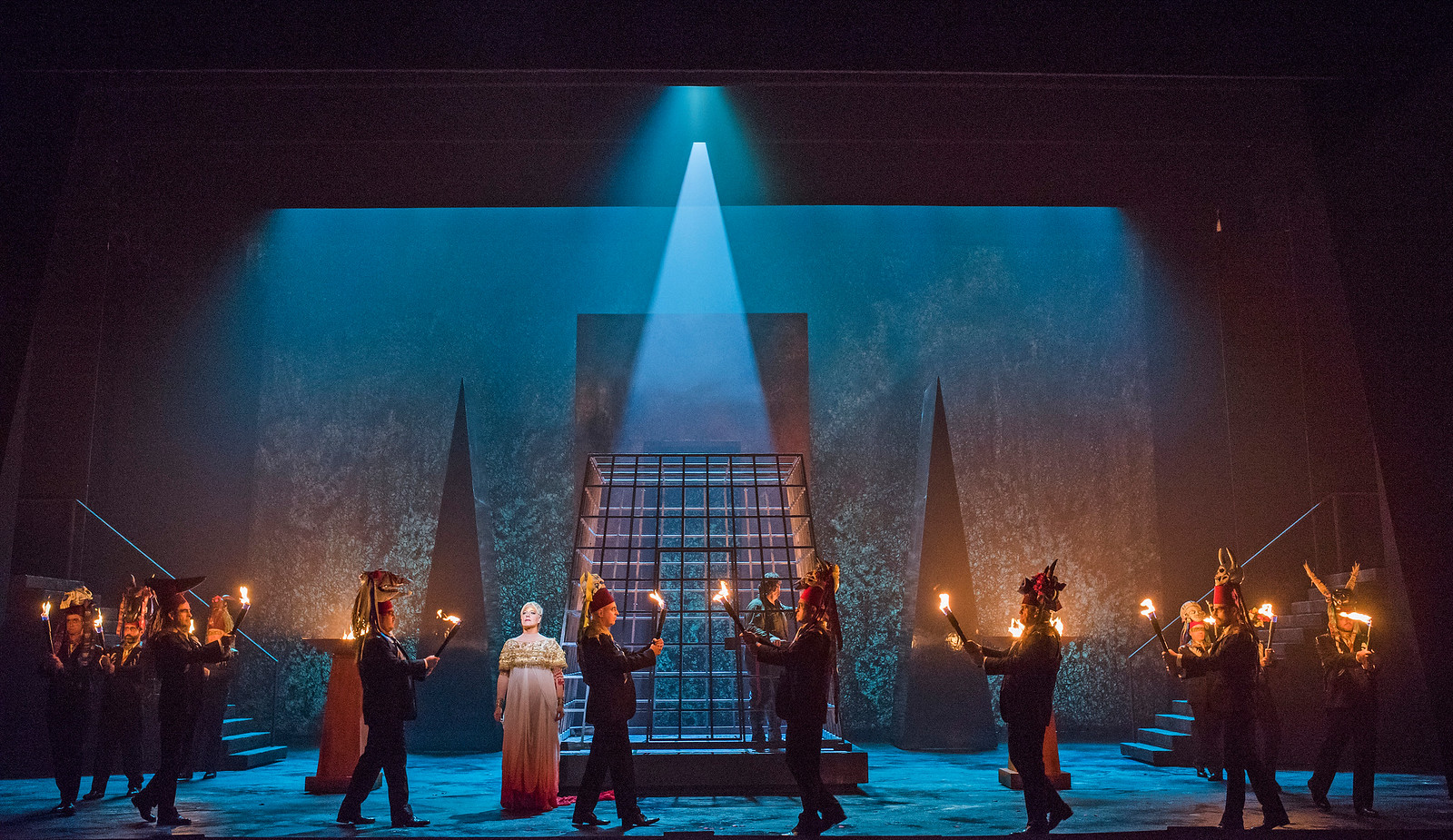
The stakes could not have been higher. The chaos could not have been wilder. It’s fair to say that no production in the Metropolitan Opera’s history has been more vexed than the new staging of Puccini’s “Tosca” that opened on New Year’s Eve.
First, months ago, its star tenor pulled out. Then its star soprano. Then her husband, who was slated to conduct.
His replacement, James Levine, a fixture at the company for four decades, was suspended from the Met last month over accusations of sexual misconduct. And a few weeks ago, for good measure, the opera’s villain canceled too.
It speaks to the Met’s resourcefulness that it was able to field such an impressive premiere cast — the rising stars Sonya Yoncheva and Vittorio Grigolo and the stalwart Zeljko Lucic — on such relatively short notice. But even with some exciting singing, this “Tosca” could point the company in the wrong direction.

The production was already, before all the withdrawals, a kind of referendum on Peter Gelb, the company’s general manager. Early in his tenure, in 2009, Mr. Gelb replaced Franco Zeffirelli’s lavish 1985 “Tosca” with a grim, irreverent staging by Luc Bondy. The boos were loud; some patrons and most (though not all) critics rebelled. The Bondy “Tosca” became a proxy war in the battles that rage in opera between tradition and innovation.
Mr. Gelb eventually gave in, calling the production “one of the blunders of my tenure.” In a recent interview he was even more abject.
ADVERTISEMENT
“I’ve learned my lesson,” he said. “When it comes to a classic piece of repertoire, beauty counts — and that’s what the audience wants.”
But Mr. Gelb has learned the wrong lesson. The discouraging implication of the new “Tosca,” directed by David McVicar, is that when it comes to staging standard repertory works, modern is bad.

That’s simply not true. Look at the critical and popular success that has greeted the Met’s highly stylized version of “La Traviata”; or its surreal, ominous “Hansel and Gretel,” onstage through Jan. 6; or its post-apocalyptic “Parsifal,” set to return next month. Mr. Bondy’s “Tosca” was unsuccessful because it was messily conceptualized and gratuitously sordid, not because a gritty, dark take on this work is an impossibility.
If beauty is going to be his criterion, Mr. Gelb should be careful to ensure that his definition of that word remains expansive, encompassing more than just Mr. McVicar’s traditional-looking, scrupulously inoffensive “Tosca.”
Almost admitting that he has nothing particularly new to say about the work, Mr. McVicar fills his staging with dozens of details, actorly touches that help the performers bring freshness and subtlety to characters every opera fan knows intimately. This was a retro night at the opera, aimed at the Met’s conservative core.
When the lights went up on Act I, the gilded interior of the Church of Sant’Andrea della Valle in the Rome of 1800, the Met audience broke into applause, just as it always did with Zeffirelli spectacles. The creative team (sets and costumes are by John Macfarlane) didn’t even try to mask echoes of Zeffirelli throughout. But, with Mr. Macfarlane’s painterly designs and sharply raked floors, the sets were an improvement over the 1985 staging, less garishly opulent, more attractive.

Jumping in for Kristine Opolais and Jonas Kaufmann, who canceled, Ms. Yoncheva and Mr. Grigolo were both singing their roles for the first time, and they looked wonderfully youthful as Puccini’s lovers, the opera diva Floria Tosca and the painter Mario Cavaradossi. They saved the day and gave compelling performances, but their greenness came through, in different ways.
Ms. Yoncheva is coquettish and passionate, fragile and fretful. Prima donna airs do not come naturally to her refined, thoughtful Tosca. Her sound, though not creamy, is richly textured and shimmering. It was fascinating to hear Tosca’s anguished Act II aria, “Vissi d’arte,” delivered as a true reflection, almost pensively. Still, for all the elegance and ardor of her singing, she did not seem like someone who had just endured her lover’s torture and condemnation to death. Tosca’s bursts of fury and jealousy seemed forced.
Coltish, feral and passionately in love, Mr. Grigolo’s Mario is a true hothead. This singer has drawn criticism for what some find to be almost animalistic singing and acting. I’ll take the trade-off of some vocal rawness and overly impulsive moments for the virile excitement he brings, complete with thrilling top notes. And you can’t say a tenor who so tenderly shaped the dulcet phrases Mario sings to Tosca after he learns she has murdered Scarpia, the malignant police chief, lacks lyrical grace.
Mr. Lucic (stepping in for Bryn Terfel) is better at conveying the suavely aristocratic ways that Scarpia manipulates those he tries to control than he is at tapping into the character’s warped malevolence. Still, the legato elegance and vocal weightiness of his singing have their own rewards. In Act II, trying to persuade a seated Tosca to reveal a convict’s whereabouts, he is creepily intimate, leaning on an armrest and looming over her.
Emmanuel Villaume, the last conductor standing at the end of the train of withdrawals, does not go for the obvious in his conducting of Puccini’s volatile music. He brings shape, nuance and pliancy to the score. There were a few out of sync moments. But following the impetuous Mr. Grigolo cannot be easy.
Review: A Traditional ‘Tosca’ Returns, With Cheers, to the Met

By Mark McLaren, Editor in Chief, January 1, 2018
A pretty new Tosca arrived at the Metropolitan Opera last night, made exciting by the stunning work of tenor Vittorio Grigolo and an impressive debut by soprano Sonya Yoncheva in the haunted title role.
But not before a tortured journey. The Met’s Tosca drama started in 2009 when general manager Peter Gelb replaced the popular Zeffirelli staging with a spare, sexy and artistically successful production by Luc Bondy, enraging much of the Met’s core audience. Subscriber attrition (to death among other variables) is a concern for the organization, and the Met announced its new (ish) Tosca as a white flag to that constituency.

Set model for David McVicar’s ‘Tosca,’ set design by John Macfarlane; photo: Metropolitan Opera Technical Department.
Drama continued as the production lost all of its principals including tenor Jonas Kaufmann and soprano Kristine Opolais. Conductor Andris Nelsons exited, and his replacement, longtime Metropolitan Opera music director (and Met artistic director between 1986 and 2004) James Levine, who made his Met debut with Tosca in 1971, was permanently dismissed by the Met for inappropriate MeToo behavior during his early career.
But the Metropolitan Opera House, the building itself it seems, breathed an enormous sigh of relief last night as Grigolo dove into a full-throated and gorgeously committed “Recondita armonia.” The tenor has become a house favorite following singular performances in last season’s Roméo et Juliette and Werther. Good tenors are hard to find and great tenors are rare. This great tenor’s sound is gorgeous and comfortable, round and robust throughout his range. And it’s as dependable as a full moon. He brings to this impressive sound singing that is uninhibited and vocal scenes that are delightful raw emotion. It would be difficult to find a better live performance of “Recondita” or “E lucevan le stelle” than those heard last night at the Met.

Vittorio Grigolo and Sonya Yoncheva in the Met’s new production of ‘Tosca;’ photo: Ken Howard/Metropolitan Opera.
Since her 2013 debut, Yoncheva has also, rightly, become a Met house favorite. Like another famous Tosca, Yoncheva’s role choices have been broad and like Grigolo, her voice is both youthful and mature, deep and rich, confident and expressive. Yoncheva, who brought the house down last night with “Vissi d’arte,” will be in opera headlines for decades.
Both are confident actors, Grigolo jumping feet-first while Yoncheva makes careful and clean decisions. Both are gripping together. The bariton Željko Lučić rounds out this Tosca trio as a smartly well-sung and concisely sadistic Scarpia.

Željko Lučić and Sonya Yoncheva in Met Opera’s ‘Tosca;’ photo: ken Howard/Metropolitan Opera.
Drama, theatrical integrity and vocal prowess reign in this Tosca, accompanied sumptuously by the Metropolitan Opera orchestra under Emmanuel Villaume.
John Macfarlane’s set is, if dull, grandly realistic. It’s pretty. It’s most impactful moment may be the production’s show’s curtain, Archangel Michael watching over the proceedings sword in hand. But the physical production is Zeffirelli-lite and if the Met’s subscriber base wanted Zeffirelli’s Tosca, it’s confusing as to why Zeffirelli’s Tosca isn’t onstage as this season’s Metropolitan Opera’s Tosca.
But so be it. This cast is well worth taking in. Later in the run, two other sopranos add Tosca to their repertoire. In May, superstar and another Met house soprano Anna Netrebko debuts her heroine in what will be a career step as anticipated as it is logical.
And excitingly, the very young American soprano Jennifer Rowley takes on the iconic role following a successful Met bow last season as Roxane in its Cyrano de Bergerac (reviewed here) and following a Met debut as Musetta in 2014. ZEALnyc profiledRowley prior to last season’s Cyrano.






 Still, there’s spectacle, and everyone loves spectacle, except they might love this one a little bit less. It has its moments. The large, static choral scenes match the monolithic shapes of Tom Pye’s sets to some degree, there are some pretty colours, with rippling silk effects created by Basil Twist; and the beautiful, slanted, varied lighting by Bruno Poet is the subtlest thing on stage. But too often the static direction becomes almost ossified. Kevin Pollard’s timeless costumes don’t always help. Elaborate hieroglyph-inspired head-pieces, exotic venerations of Isis (ancient goddess, not so-called Islamic State), and Radames’s rather 19
Still, there’s spectacle, and everyone loves spectacle, except they might love this one a little bit less. It has its moments. The large, static choral scenes match the monolithic shapes of Tom Pye’s sets to some degree, there are some pretty colours, with rippling silk effects created by Basil Twist; and the beautiful, slanted, varied lighting by Bruno Poet is the subtlest thing on stage. But too often the static direction becomes almost ossified. Kevin Pollard’s timeless costumes don’t always help. Elaborate hieroglyph-inspired head-pieces, exotic venerations of Isis (ancient goddess, not so-called Islamic State), and Radames’s rather 19 None of the visuals would matter if the characters were fully explored and their interactions were vivid, but few were the moments when that happened; and instead of addressing one another, they mostly had to stand metres apart and bark forwards. Some crucial scenes barely featured eye contact.
None of the visuals would matter if the characters were fully explored and their interactions were vivid, but few were the moments when that happened; and instead of addressing one another, they mostly had to stand metres apart and bark forwards. Some crucial scenes barely featured eye contact. The chorus mostly stood and delivered, which they did extremely well, with the hushed moments especially fine. There was strong playing from the orchestra under the baton of Keri-Lyn Wilson, who took often brisk tempi and provided solid support to her soloists’ voices, mainly without drowning them in orchestral splendour and cavernous Coliseum space.
The chorus mostly stood and delivered, which they did extremely well, with the hushed moments especially fine. There was strong playing from the orchestra under the baton of Keri-Lyn Wilson, who took often brisk tempi and provided solid support to her soloists’ voices, mainly without drowning them in orchestral splendour and cavernous Coliseum space.